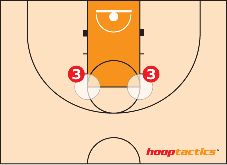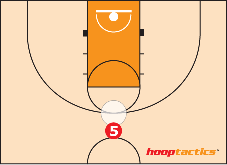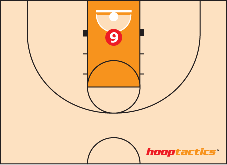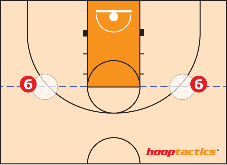
Positions and court
The Baskets
Well the first basket was actually a fruit basket and you had to shot the ball in and poke it out with a large and long stick about a decade after the invention of the sport the hoop evolved into a circular metal rim with netting and it was closed at the bottom so again they had to climb up and retrieve the ball. But then finally in 1906 the cut the net so the ball could just fall through so it would be easier to continue with the game and the evolution continued with the development of the backboard. Now the hoops have special measurements the ring has to be 18 inches in diameter and the net can be 15-18 inches long plus the rim has to be 10 feet from the floor. Also a fun fact nowadays the rim is flexst so when players dunk the don't bend the rim or shatter the backboard.

Backboard
The original reason for the backboard was that the games we're always interfered by the fans because they kept throwing and hitting the ball when players shot and with no backboard rebounding was not an option. So when it was created it in 1893 they were much smaller and rebounding was possible then players realized also that they can use the board when shooting bounce it from the board into the basket. The first board was made from chicken wire but as time passed people were suffering injuries from trying to hit the ball from the basket and wood boards were quickly adapted this was in 1904 but only five years later in 1909 glass boards were adapted and to this day we use glass boards but it’s fiberglass and isn’t as easy to break. The square on the board is not to this day known when it came but its was a key part in the sport pretty quick.

The Basketball court
The court is 94 by 50 feet (29 by 15 m). Under International basketball Association(FIBA) the court is minutely smaller, measuring exactly 28 by 15 metres (92 by 49 ft). A high school court is slightly smaller, at 84 by 50 feet (26 by 15 m). In amateur basketball, court sizes are in warious sizes. The baskets are always 10 feet (around 3.0 m) above the floor (except in young competition). Basketball courts have a three-point line at both baskets. A basket made from behind this line is worth three points; a basket made from within this line, or with a player's foot touching the line, is worth 2 points. The free-throw line, where one stands while taking a foul shot, is located within the three-point line at 15 feet from the basket. A foul shot is worth 1 point, but if a shot is made from the foul line while in play it is still worth 2 points. The court itself

Court Areas

1. Sidelines.
The sidelines mark the end of the court and that means if you step out of them with the ball your team loses the ball.

2. Baseline/Endline.
These lines also mark the end of the court and the same goes for it but when the team losses the ball by either a foul or the ball going of court the take a inbound on the sidelines or the baseline

3. Mid court line.
This line divides the court in half, when an offense team is playing the ball on one half of the court is there scoring side and the other half is there defence side.

5. Free throw line.
This line is a boundary line for shooting free throws and is 15 feet away from the board. When the shooter is taking a shot he cannot step on or over the line when shoting until after the ball has hit the rim of the basket.

7. Lane line
These lines are boundaries and run from the free throw line to the baseline. The lenght of the lines depend on vary levels of the game. The lane lines also contain lane spaces markings used to align and separate the non-shooters. The first lane space, on both sides of the basket, are occupied by the opposing team from the free throw shooter. Non-shooters cannot step into the three second area until the ball leaves the free throw shooter's hand.

4. Three point line.
If someone takes a shot from the back of this line and scores the get three points.

6. Free throw circle.
This circle is 12 feet in diameter when the shooter must remain inside the free throw circle. On jump balls, non-jumpers must remain outside the circle until the ball is tapped by one of the jumpers.

8. Center
This is where the game starts with the referee throwing the ball up in the air and one member from each team is in the circle while others are around it so they have to hit the ball and pass it to their teammates while they cannot be inside the ring until the ball is in someone's hands.
Half court

1. Three second Area
If an offensive player is in the paint area for three seconds it´s violation and the other team gets the ball.

3. Elbow
This is also a great place to be for the defence and offence just by planting yourself there can give you many opportunities for plays.

5. Top of Circle(key)
This top is primarily used for the reference for aligning offensive and defensive players, plus this spot is where many players like to shot.

7. Corner
This is another favorite spot to shot and is a good place forn spacing(not everyone smushed together and no one can cut in and try to get the ball. And it exercises zone defence a play for the defence team.


2. Block
This block has many purposes like to post up which is steping into the defensive player and get the ball and make a move to score under the basket. And when a free throw is being taken the offensive player is above the block while the defence is under and tries to step out the other player.

4. Free throw Line extended
This line from the free throw line is for a defencive rule when the ball is above this line the defencive team has a stratity and when the ball is under the line the have a different approach. The referee uses it also for offencive player alignment.

6. Wing
These wings are used for a definition of “Ballside” and “Weakside” of the court. The ballside is where the ball is in play and the weakside is where the ball isn’t in play.

8. Short Corner
It is a strategic offensive area especially used against zone defenses.
9. Restricted Area (Pro)
This area is pro and is mostly used because no offensive charges can be taken by defenders when they are positioned on or inside this area, it is always a foul.
Players position
Players positions
There are 5 players on the court 10 in total so there are five positions. Each player tries to make something and open themselves and shot or cut in the middle. Number 1 the pointer who controls the plays and makes sure everyone is in position. Then the 2 and 3 the are on opisite wings and or one on a wing and the other on the corner they assist with taking the ball inn. Then player number 4 he is the one who takes the inbound and is always next to the pointer. Then number 5 the big one this is normally a tall player who gives screens and tries to post up or get the ball into the paint area and dish it out for a open shot.
The amount of players
There are always 5 players on the court from each team but you can have up to 12 players overall so you can switch in and if someone gets hurt you have another player to go in instead. There are no rules that say you have to have 12 players just five and the rest is up to you.
